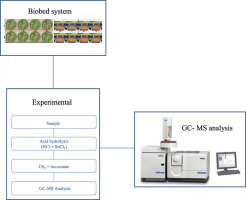Talanta ( IF 5.6 ) Pub Date : 2018-03-08 , DOI: 10.1016/j.talanta.2018.03.009 Catiucia S. Vareli , Ionara R. Pizzutti , Luciano Gebler , Carmem D. Cardoso , Daniela S.H. Gai , Marlos E.Z. Fontana

|
In order to evaluate the efficiency of biobeds on DTC degradation, the aim of this study was to apply, optimize and validate a method to determine dithiocarbamate (mancozeb) in biobeds using gas chromatography-tandem mass spectrometry (GC-MS).
The DTC pesticide mancozeb was hydrolysed in a tin (II) chloride solution at 1.5% in HCl (4 mol L−1), during 1 h in a water bath at 80 °C, and the CS2 formed was extracted in isooctane. After cooling, 1 mL of the organic layer was transferred to an auto sampler vial and analyzed by GC-MS.
A complete validation study was performed and the following parameters were assessed: linearity of the analytical curve (r2), estimated method and instrument limits of detection and limits of quantification (LODm, LODi, LOQm and LOQi, respectively), accuracy (recovery%), precision (RSD%) and matrix effects. Recovery experiments were carried out with a standard spiking solution of the DTC pesticide thiram. Blank biobed (biomixture) samples were spiked at the three levels corresponding to the CS2 concentrations of 1, 3 and 5 mg kg−1, with seven replicates each (n = 7).
The method presented satisfactory accuracy, with recoveries within the range of 89–96% and RSD ≤ 11%. The analytical curves were linear in the concentration range of 0.05–10 µg CS2 mL−1 (r2 > 0.9946). LODm and LOQm were 0.1 and 0.5 mg CS2 kg−1, respectively, and the calculated matrix effects were not significant (≤ 20%). The validated method was applied to 80 samples (biomixture), from sixteen different biobeds (collected at five sampling times) during fourteen months. Ten percent of samples presented CS2 concentration below the LOD (0.1 mg CS2 kg−1) and 49% of them showed results below the LOQ (0.5 mg CS2 kg−1), which demonstrates the biobeds capability to degrade DTC.
中文翻译:

分析方法验证可评估巴西南部生物床中二硫代氨基甲酸酯的降解
为了评估生物床对DTC降解的效率,本研究的目的是应用,优化和验证使用气相色谱-串联质谱(GC-MS)测定生物床中二硫代氨基甲酸酯(mancozeb)的方法。
将DTC农药代森锰锌在1.5%的HCl(4 mol L -1)的氯化锡(II)溶液中于80°C的水浴中水解1小时,并将形成的CS 2萃取至异辛烷中。冷却后,将1 mL有机层转移至自动进样器样品瓶中,并通过GC-MS分析。
进行了完整的验证研究,并评估了以下参数:分析曲线的线性(r 2),估计的方法和仪器的检出限和定量限(分别为LODm,LODi,LOQm和LOQi),准确性(回收率%) ),精度(RSD%)和矩阵效果。使用DTC农药噻吨的标准加标溶液进行回收实验。将空白生物床(生物混合物)样品加标为与CS 2浓度分别为1、3和5 mg kg -1的三个水平,每个重复7次(n = 7)。
该方法具有令人满意的准确性,回收率在89–96%范围内,RSD≤11%。在0.05–10 µg CS 2 mL -1的浓度范围内,分析曲线呈线性(r 2 > 0.9946)。LODm和LOQm分别为0.1和0.5 mg CS 2 kg -1,并且计算出的基质效应不明显(≤20%)。经过验证的方法在十四个月中应用于来自十六个不同生物床(以五个采样时间采集)的80个样品(生物混合物)。百分之十的样品的CS 2浓度低于LOD(0.1 mg CS 2 kg -1),其中49%的样品的结果低于LOQ(0.5 mg CS 2)kg -1),这证明了生物床降解DTC的能力。









































 京公网安备 11010802027423号
京公网安备 11010802027423号